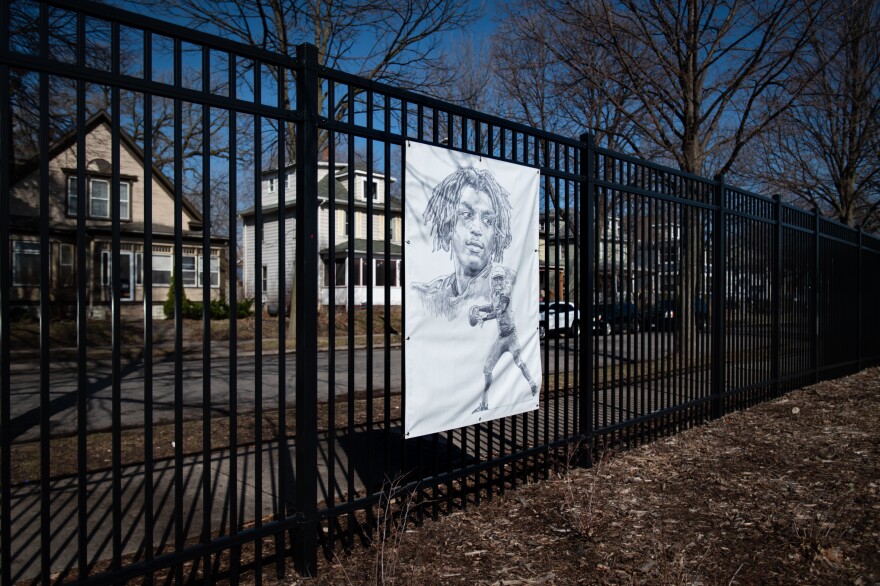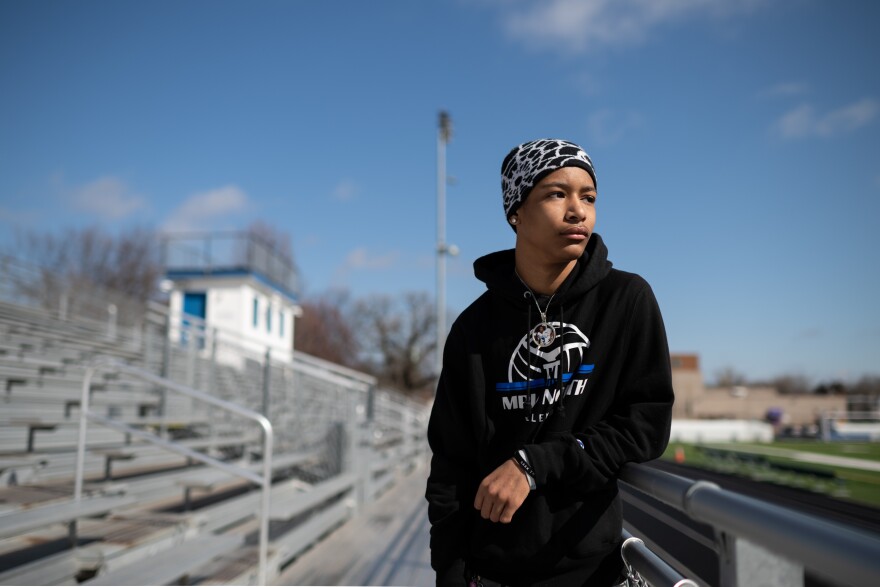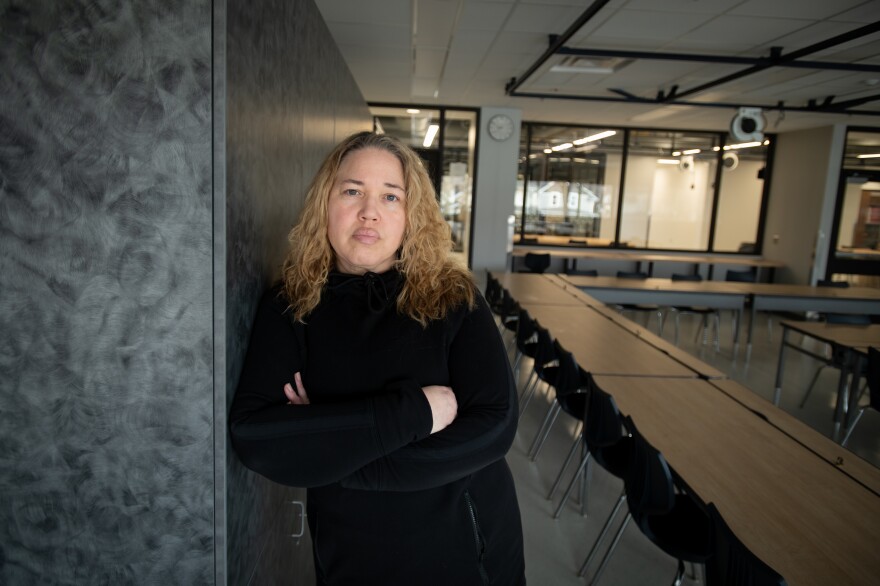The students at North Community High School in Minneapolis have seen a lot. Some things, morbid curiosities: a bullet, freshly fired, spinning and melting the rubber on the track surrounding the school's football field.
Others, much more painful: the murder of Deshaun Hill Jr., shot and killed two years ago just blocks from the school. He was 15 years old, and the quarterback of the football team.
"That was my best friend, so we did everything with each other. I feel like that's the toughest thing, just knowing that he's not physically by my side anymore," senior Kahlil Brown says.
Last spring, another member of the football team was shot in both legs. He survived.
"It is not normal. It shouldn't be seen as normal. But we go through it so much that it is normal here," senior Jalen Beard says.

Across the country, millions of young people are enduring this same reality: Firearm injuries are the leading cause of death for children and teens over age 1 nationwide.
The federal government is investing billions of dollars to combat this problem. But on the north side of Minneapolis, some students living under the threat of gun violence say there's a disconnect between what the government is offering and what they say they need.
"We needed that police officer at our school and they took it out"
Gun violence affects children and teenagers in devastating ways, says Sonali Rajan, an associate professor at Columbia University's Teachers College. That goes far beyond the physical harm guns can cause.
"Witnessing firearm violence, surviving a shooting, hearing gunshots," Rajan says. "There's a real range of experiences that we have to consider when we think about its impacts and the emotional trauma that goes hand-in-hand with that — nightmares, anxiety, difficulty concentrating, typical symptoms we might associate with post-traumatic stress disorder."
Students exposed to gun violence are less likely to do well in school and less likely to graduate. What's more, the rate of firearm deaths for Black children is six times higher than it is for white children. In Minneapolis, students at North High are well aware of those effects.
"If you're outside, you don't really feel comfortable, you don't really get to relax," Beard says. "Even if you're not the one doing it, even if you're not a part of no gang, nothing like that. But you could still end up being the one on the ground."

In response, the Biden administration is awarding $1 billion across the next several years as part of the Bipartisan Safer Communities Act. That money aims to increase the number of mental health professionals in schools.
As part of the same legislation, the administration distributed about another $1 billion in grants to create what it calls "safer and healthier learning environments," employing a wide range of strategies — including anti-bullying and violence prevention programs, staff training and metal detectors.
Minneapolis Public Schools will receive at least $500,000 of this federal aid, much of which is focused on drug and alcohol prevention. The district plans to apply for the mental health grants and has received other state and federal funding specifically for preventing gun violence.
When it comes to more mental health resources, Beard says he would welcome that extra support, as long as a counselor can truly relate.
"You don't want to talk to a stranger who has never been in this situation, who never had one of their best friends pass away at 15," Beard says. "They wouldn't understand. And it would feel like I'm talking to an alien, basically."
In 2020, George Floyd was murdered by a police officer in this same city. Shortly after, the school district ended its contract with the city's police — and pulled school resource officers from its buildings.
"So now the police is out of our schools," says Brown, the senior whose best friend was killed. "We needed that police officer at our school and they took it out."
The school still has a security monitor, but that person is not a sworn officer. The security monitor can't arrest people and doesn't carry a weapon. Students say they don't want to be overpoliced, much less by officers they don't know. But at North, the school resource officer was also the head coach of the football team — and still is.
"That's a trusted person," Beard says. "If I knew my coach was out there protecting me, I'm fine."

Studies have shown the presence of police can criminalize the school space and serve as a pipeline into the criminal justice system, says Rajan, the Columbia researcher. Still, she says, the need for real physical safety is valid.
"We can't necessarily employ a cookie cutter approach to gun violence prevention," Rajan says. "There are 51 million children in our public school system right now. So there is a lot of nuance here we have to contend with."
"What are we doing to prevent that violence from happening at all?"
Every morning, Principal Friestleben stations herself in the hallway to greet students. She says that's intentional: Structure and consistency communicate to students that they're safe.
"My children are walking in with generational and personal experience of not being protected and not being valued and centered," she says.

Educators need to understand that even though they can't control what happens in the neighborhood, schools can make a real difference in student well-being, says Dan Flannery, a professor who researches gun violence at Case Western Reserve University.
"If you have a positive school climate and culture, if kids feel attached to the school, they're going to have a much more positive experience," Flannery says. "You need to have a commitment to that perspective. The staff and teachers and principals have to understand that this is an important thing to do."
The all-hands-on-deck approach is part of a larger way of thinking: treating gun violence as a disease.
"Public health is predicated on the notion that we should invest as much as we can in what we call primary prevention," Rajan says. "Prevention is saying 'What are we doing years and years before an individual is posing a potential threat to a school community? What are we doing to make it harder? What are we doing to prevent that violence from happening at all?'"
She says alongside stricter gun laws, strengthening communities at large — investing not just in school culture, but also in things like affordable housing and neighborhood green space — can act as a sort of vaccine against violence.
Friestleben wants to see that investment. And though she welcomes the funds, she isn't sure the latest federal grants will get at the root problems that can lead to gun violence.

"It's no different than one of my kids being hungry and going to the corner store and getting chips. It's satisfying a teeny, tiny little bit of hunger, but not in a healthy, sustainable, longstanding way," she says.
This year Jalen Beard and Kahlil Brown will graduate and go on to college.
They'll attend St. Olaf College, a small liberal arts school about 45 miles from home. They're going to be roommates, and they'll both be playing football, something they talked about doing with their friend who's no longer here.
"He wasn't getting in trouble. He went to class. He had good grades," Beard says. "To me, he was doing everything right. He was doing everything he was supposed to be. And he still didn't get his opportunity."
Note: Meg Anderson was a teacher for Minneapolis Public Schools several years ago. Her spouse works for the district.
Copyright 2025 NPR



